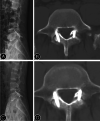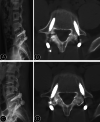Retrospective Comparative Study of Pedicle Screw Fixation via Quadrant Retractor and Buck's Technique in the Treatment of Adolescent Spondylolysis
- PMID: 34881509
- PMCID: PMC8755885
- DOI: 10.1111/os.13165
Retrospective Comparative Study of Pedicle Screw Fixation via Quadrant Retractor and Buck's Technique in the Treatment of Adolescent Spondylolysis
Abstract
Objective: To compare the effectiveness and practicality of pedicle screw fixation via the Quadrant retractor and Buck's technique in the treatment of adolescent spondylolysis.
Methods: A total of 31 patients who underwent pedicle screw fixation or Buck's technique at our hospital from 2012 to 2017 were selected for this retrospective study. The patients were divided into a pedicle screw group (16 patients) and a Buck's technique group (15 patients) according to surgical procedure. Age, sex, disease duration, involved segments, preoperative Oswestry disability index (ODI) scores, visual analogue scale (VAS) scores for low back pain (LBP), intraoperative blood loss, incision length, operative time and length of hospital stay were documented. ODI scores, VAS scores for LBP and fusion rates at 1 month, 6 months, 1 year and 3 years postoperatively were used to evaluate surgical outcomes.
Results: The average follow-up period was 32.75 ± 11.99 months in the pedicle screw group and 31.02 ± 9.64 months in the Buck's technique group. No significant differences in demographic data and perioperative data were found between the two groups (P > 0.05). The ODI scores and VAS scores for LBP in both groups were significantly improved at 3 years postoperatively compared with the values before surgery (ODI%: 45.74 ± 2.47 vs 10.99 ± 3.00; 45.29 ± 6.94 vs 15.73 ± 6.89. VAS: 5.94 ± 0.68 vs 1.50 ± 0.52; 6.13 ± 0.74 vs 2.13 ± 0.92, P < 0.05). The ODI scores of the patients in the pedicle screw group at 1 month to 3 years postoperatively were lower than those of the patients in the Buck's technique group (P < 0.05). Moreover, the VAS scores for LBP of the patients in the pedicle screw group at 6 months and 3 years postoperatively were lower than those of the patients in the Buck's technique group (P < 0.05). No significant difference in the VAS scores for LBP was found between the two groups at 1 month postoperatively (3.88 ± 0.50 vs 4.20 ± 0.56, P = 0.10). Three years postoperatively, good fusion of the pars interarticularis was achieved in all patients in the pedicle screw group, but four patients in the Buck's technique group did not achieve good fusion (P = 0.02).
Conclusion: Both pedicle screw fixation and Buck's technique can achieve good outcomes in the treatment of adolescent spondylolysis. Pedicle screw fixation via the Quadrant retractor for the treatment of spondylolysis is associated with more satisfactory effects in terms of LBP relief and fusion results.
Keywords: Adolescent; Buck's technique; Pedicle screw system; Spondylolysis.
© 2021 The Authors. Orthopaedic Surgery published by Chinese Orthopaedic Association and John Wiley & Sons Australia, Ltd.
Figures




References
-
- Winter M, Jani L. Results of screw osteosynthesis in spondylolysis and low‐grade spondylolisthesis. Arch Orthop Trauma Surg, 1989, 108: 96–99. - PubMed
Publication types
MeSH terms
Grants and funding
LinkOut - more resources
Full Text Sources
Miscellaneous

